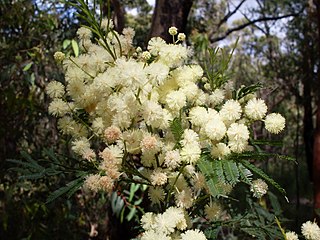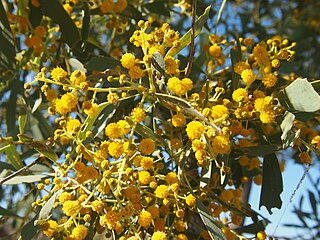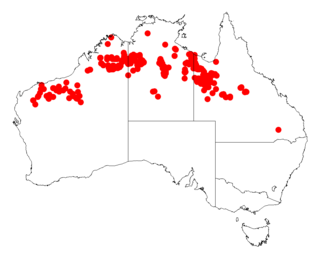
Acacia cultriformis, known as the knife-leaf wattle, dogtooth wattle, half-moon wattle or golden-glow wattle, is a perennial tree or shrub of the genus Acacia native to Australia. It is widely cultivated, and has been found to have naturalised in Asia, Africa, North America, New Zealand and South America. A. cultriformis grows to a height of about 4 m (13 ft) and has triangle-shaped phyllodes. The yellow flowers appear from August to November in its natural range. Its attractive foliage and bright flowers make it a popular garden plant.

Acacia tetragonophylla, commonly known as curara, kurara or dead finish, is a tree in the family Fabaceae that is endemic to arid and semi-arid parts of central and western Australia.

Acacia harpophylla, commonly known as brigalow, brigalow spearwood or orkor, is an endemic tree of Australia. The Aboriginal Australian group the Gamilaraay peoples know the tree as Barranbaa or Burrii. It is found in central and coastal Queensland to northern New South Wales. It can reach up to 25 m (82 ft) tall and forms extensive open-forest communities on clay soils.

Acacia parramattensis, commonly known as Parramatta wattle, is a tree of the family Fabaceae native to the Blue Mountains and surrounding regions of New South Wales. It is a tall shrub or tree to about 15 m (49 ft) in height with phyllodes instead of true leaves. These are finely divided bipinnate. The yellow flowers appear over summer. It generally grows in woodland or dry sclerophyll forest on alluvial or shale-based soils, generally with some clay content.

Acacia podalyriifolia is a perennial tree which is fast-growing and widely cultivated. It is native to Australia but is also naturalised in Malaysia, Africa, India and South America. Its uses include environmental management and it is also used as an ornamental tree. It is very closely related to Acacia uncifera. It grows to about 5 m in height and about the same in total width. It blooms during winter.

Acacia maitlandii, also known as Maitland's wattle, is a perennial tree native to Australia.

Acacia decora is a plant native to eastern Australia. Common names include the western silver wattle and the showy wattle. The species name refers to the plant's decorative qualities.

Acacia volubilis, also known as tangle wattle, is a shrub belonging to the genus Acacia. It is native to a small area in the Wheatbelt region of Western Australia. It has been declared endangered under the Commonwealth Environment Protection and Biodiversity Conservation Act 1999.

Acacia gonocarpa, commonly known as wuluru, is a tree or shrub belonging to the genus Acacia and the subgenus Juliflorae. It is native to northern Australia.

Acacia leptophleba is a shrub belonging to the genus Acacia and the subgenus Juliflorae that is endemic to northern Australia.

Acacia ampliceps, also known as salt wattle, is a shrub or tree belonging to the genus Acacia and the subgenus Phyllodineae. It is native to northwestern parts of Australia.

Acacia dictyophleba, also known as the sandhill wattle, waxy wattlefeather veined wattle, and spear tree, is a shrub belonging to the genus Acacia and the subgenus Phyllodineae. The Nyangumarta peoples know the plant as Langkur or Lungkun; the Thalanyji know it as Jabandi; and the Pintupi know it as mulyati.

Acacia iteaphylla, commonly known as Flinders Range wattle, Port Lincoln wattle, winter wattle and willow-leaved wattle, is a shrub belonging to the genus Acacia and the subgenus Phyllodineae that is endemic to South Australia.

Acacia hemignosta commonly known as the clubleaf wattle, is a tree or shrub of the genus Acacia and the subgenus Plurinerves that is endemic to northern parts of Australia.

Acacia oswaldii, commonly known as boree, umbrella wattle, umbrella bush, whyacka, middia, miljee, nella and curly yarran, is a shrub or tree of the genus Acacia and the subgenus Plurinerves.

Acacia retivenea, commonly known as the net-veined wattle, is a shrub of the genus Acacia and the subgenus Plurinerves that is endemic across northern Australia.

Acacia shirleyi, known colloquially as lancewood, is a species of Acacia native to Queensland and the Northern Territory in Australia. It grows as a tree to 15 metres (49 ft) high, with dark grey or black stringy bark and blue-grey foliage. The yellow flowers appear from March to July. It grows in dry scrub, open forest or mixed savannah woodland. Indigenous people used the wood as fuel and to make hunting spears. Cattle can eat the foliage as fodder.

Acacia fasciculifera, commonly known as scrub ironbark or less frequently as rosewood, is a tree belonging to the genus Acacia and the subgenus Phyllodineae endemic to parts of Queensland.

Acacia homaloclada, also commonly known as Hitchinbrook wattle, is a shrub of the genus Acacia and the subgenus Plurinerves that is endemic to north eastern Australia. It is listed as vulnerable according to the 1992 Nature Conservation Act.

Acacia praelongata is a shrub of the genus Acacia and the subgenus Plurinerves that is endemic to are area of northern Australia.
































